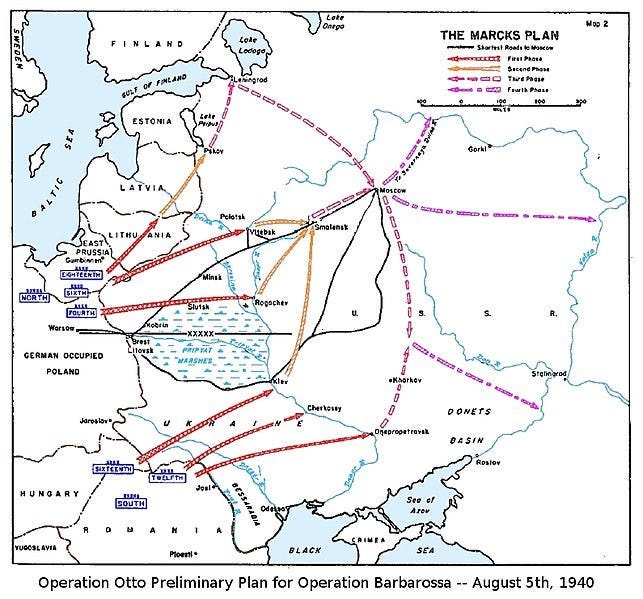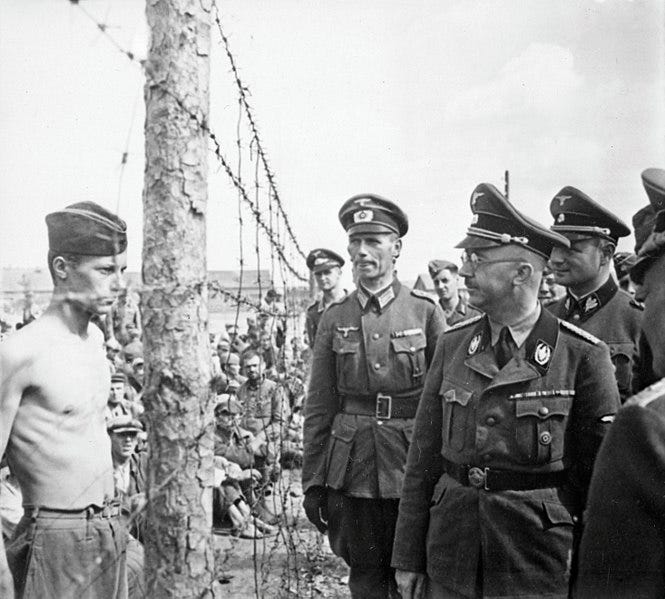How Cruel Logic Designed A Little-Known Genocide During World War II
The routine office meeting which condemned thirty million people to death

“What one is dealing with here is the blueprint for a program of mass murder unprecedented in modern history.”
—Kay, Alex J. “Germany’s Staatssekretäre, Mass Starvation and the Meeting of 2 May 1941.” Journal of Contemporary History 41, no. 4 (2006): 685–700.
Humanity often considers itself special due to logic and reason. The mental process makes us different. After all, a fish, grasshopper, or even a monkey can’t apply logic or reason the way we can.
You might say some even worship these concepts. For instance, the Stoics connected reason and logic to the cosmos, so adhering to them would innately make you one with the universe. But C.S. Lewis added a caveat to this idea.
During WWII, the author gave a series of lectures, which eventually turned into the book The Abolition of Man. In the speeches he warned about “men without chests.” This wasn’t advice on exercise.
Lewis explained the chest acted as a mediator between belly (emotion) and head (logic). While we instinctively understand the dangers of runaway emotion, logic is a harder sell.
Reason is thought to be semi-divine, and a virtue. How could it be troublesome?
Well, since I mentioned WWII, we’re going to take a field trip through time to an apparent trivial event: a work meeting on May 2, 1941. It may even look familiar. There were topics for discussion, someone taking notes (minutes), and maybe even snacks.
However, the subject calmly discussed might be the darkest in history and was formulated with an all too calculated reason. It involved the mass starvation of millions of people. All due to logistical issues.
The Problem With A Large Invasion
According to the Imperial War Museum, Nazi Germany planned its invasion of Russia — dubbed Operation Barbarossa — to begin in June of 1941. And it was a complicated affair. Multiple armies would go after different targets, traveling hundreds of miles, all while under time constraints due to the eventual winter.

While guns, tanks, planes, fuel, and soldiers are obviously important for an invasion like this, something else is critical: food. Napoleon supposedly said armies march on their stomach, which didn’t change in modern times.
Dr. Kay’s article (mentioned previously) notes specifically three million soldiers being involved in the invasion. Now, that’s a lot of food. Logistically how do you fill that many stomachs far away from home?
Not only was moving the food a problem, but the production also removed food from Germany. It was already struggling. In fact, a prime motivator for the invasion was acquiring “lebensraum,” or living space for the German people. But this also included productive farmland for feeding them.
Russia had this in abundance. So, on May 2, 1941, the administrative group at our humdrum meeting decided the German troops would live off the land within the invaded territory. They’d just grab farms, wheat, animals, and whatever else they required. Obviously, very logical.
But it did bring about some further bland topics of discussion.
Who Should Starve, So We Can Eat
“In an alarmingly matter-of-fact way, those present at the meeting declared ‘x million people’ in the soon-to-be-occupied territories of the Soviet Union would have to starve to death if Germany was to win the war.”
— Kay, Alex J. “Germany’s Staatssekretäre, Mass Starvation and the Meeting of 2 May 1941.” Journal of Contemporary History 41, no. 4 (2006): 685–700.
While the smartly dressed attendants decided the colors and design of uniforms for civilian affair officials who’d deal with the newly captured farms and food distribution, they discussed a small issue. Of course, if you take Russian civilians’ food, they can’t eat.
They quickly calculated “x” million people would starve to death. Now, this may bring you down, but it’s not as bad as you think. Logically, the more Russians that starve, the more surplus food. Furthermore, they clarified “x” in later meetings to do away with any vagary.
Dr. Kay says subsequent meetings estimated it at tens of millions, but a meeting after this boosted it to thirty million. Moreover, the attendees understood this. They specifically referred to it as the “starvation policy,” and put a logistic format into place so it could take shape.
In fact, by design it was rather simple. Sections of the Soviet Union produced more food than they consumed, while others did the reverse. So, just capture the “surplus areas” and cut off the “deficit areas.”
Commander starvation would do the rest.
The attendees expected the cities to fair the worst, but this was okay, because Russia’s prime purpose under the yoke of the Third Reich would be growing food. Some industry could survive, but only that which the Fatherland required.
Now, it makes you wonder…what kind of men would attend a meeting like this?
Not Your Typical Bloodthirsty Barbarians
These “men without chests” didn’t look like the vicious pea-brained monsters you’d expect. In fact, they were well educated. While there’s no specific list of attendees, Dr. Kay checked schedules and did some sleuthing, putting together a very likely list. He states:
“The average age of those present was approaching 50…Many of the participants were well-educated men; nigh on half held a doctorate.”
While some soldiers attended who’d been in combat, many were bureaucrats from various economic ministries or Staatssekretäres. Dr. Kay specifically says the following attended:
“…Four senior military personnel…four members of the Economics Ministry, two members of both the Reich Ministry for Food and Agriculture and the Bureau Rosenberg, and one member each of the Reich Ministries for Labor and for Transport and the Reich Forestry Office.”
However, while these men did add details to the plans, the idea was generated long before and approved by Hitler, Hermann Göring, and economic leaders of Germany. But all firmly agreed.
Dr. Kay also notes the May 2nd meeting also had odd similarities to the Wannsee Conference, where a nonchalant grouping discussed methods to enact the Final Solution. It’s all rather terrifying, but something is missing.
I’m sure there’s a question in your mind: why isn’t this more widely known? Well, there’s a good reason.
Not Quite The Genocide They Planned

As you obviously know, Germany didn’t win the war. Things fell apart on the Russian front. As losses mounted and the Soviets put up tougher resistance, the Nazis just didn’t have enough troops to cut off entire areas of Russia.
Historian Peter Frankopan in The Silk Roads: A New History of the World, also points out the mass of grain and foodstuffs Hitler expected to capture never materialized. The Germans actually procured more food by trading with Russia. Although starvation did occur.
Dr. Kay says at least six hundred thousand starved to death as Leningrad was blockaded, but Soviet prisoners fared the worst. It’s estimated three million died from “undernourishment.” But in magnitude of other Nazi crimes, it took a back seat.
Therefore, you’ve likely never heard of the May 2nd meeting because this genocide wasn’t as effective as other ones perpetrated by Hitler. But it does make us reexamine the lesson from C.S. Lewis.
While Lewis refers to a human that’s all belly (emotion) as a “trousered ape,” he notes all head (logic and reason) can be cruel and robotic. In this case the latter was millions of times worse.
-Originally posted on Medium 6/28/23


